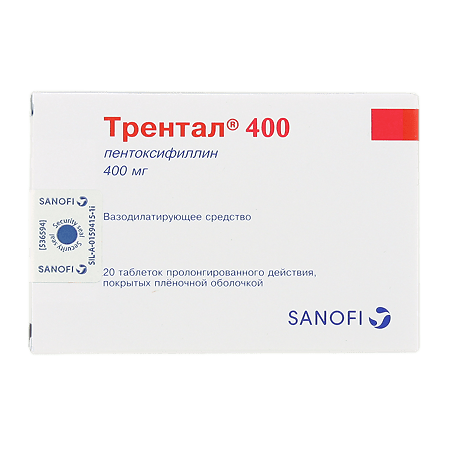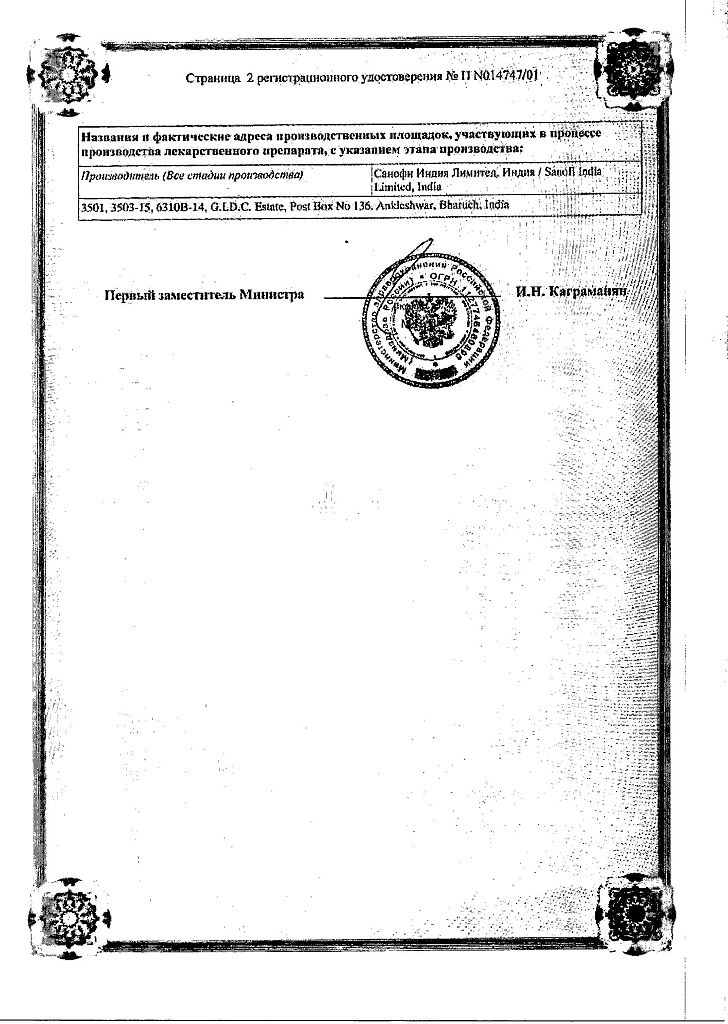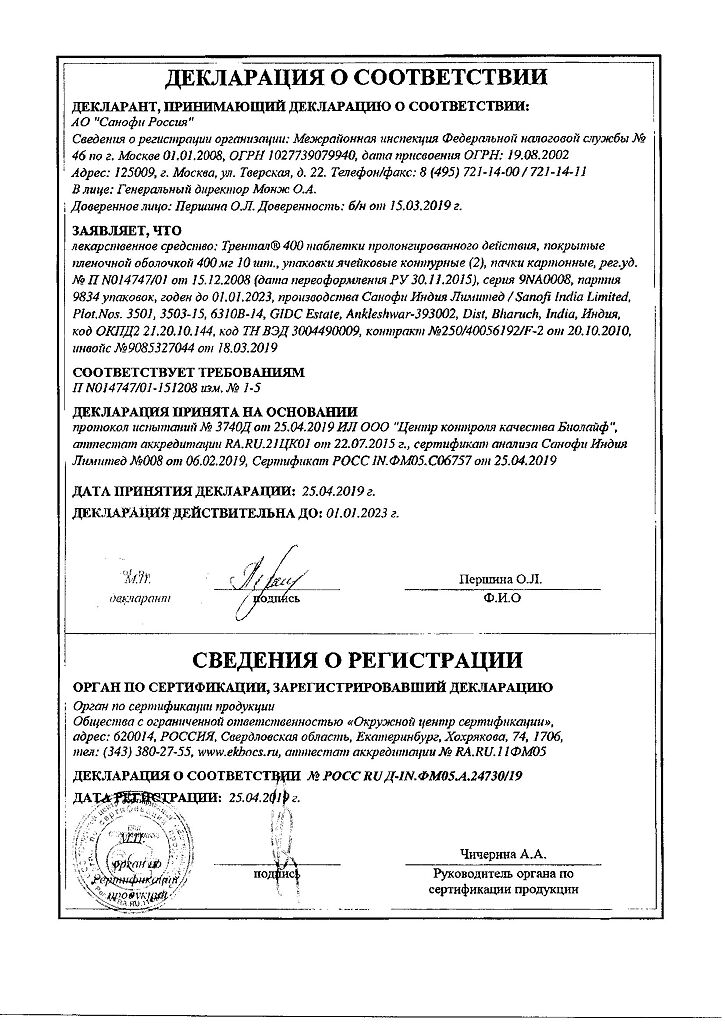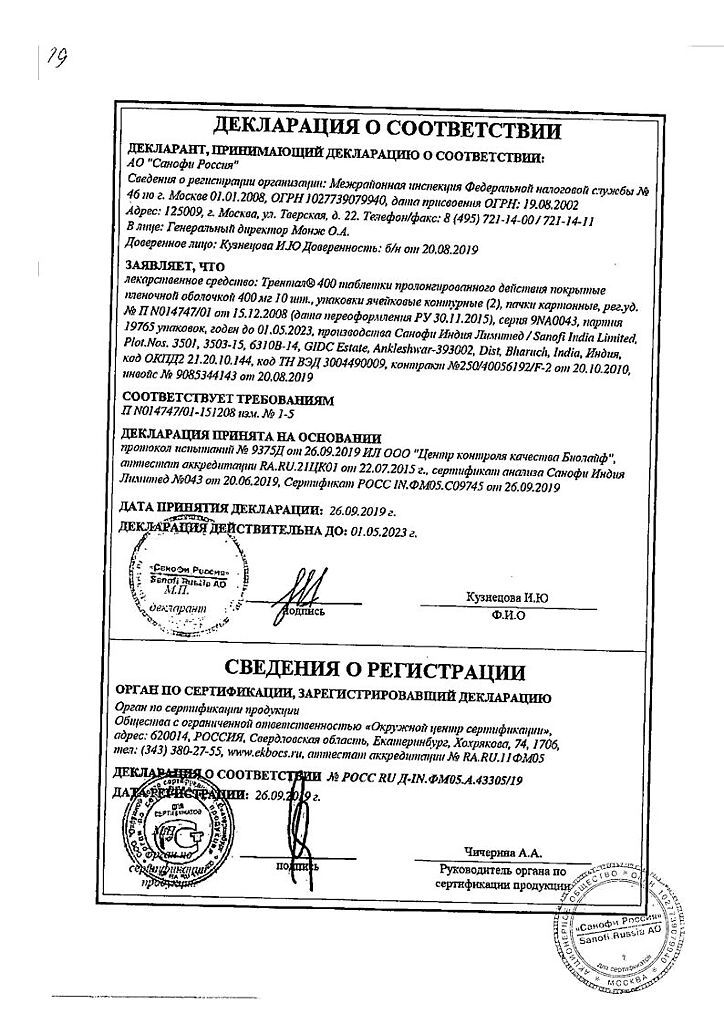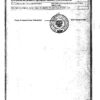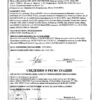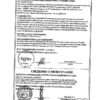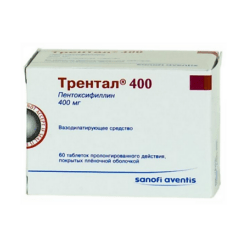No products in the cart.
Trental 400,400 mg 20 pcs
€26.89 €22.41
Description
Pharmacodynamics
The drug improving microcirculation, angioprotector, xanthine derivative. Trental improves rheological properties of the blood (fluidity) due to influence on pathologically changed deformability of erythrocytes, inhibiting platelet aggregation and reducing high blood viscosity. It improves microcirculation in the areas of disturbed blood circulation.
The mechanism of action of pentoxifylline is associated with inhibition of phosphodiesterase and accumulation of CAMF in vascular smooth muscle cells and blood cells.
With a weak myotropic vasodilatory effect, pentoxifylline slightly decreases RPS and slightly dilates coronary vessels.
The treatment with Trental leads to improvement of the symptomatology of cerebral circulatory disorders.
The success of treatment in peripheral arterial occlusive disease (e.g., intermittent claudication) is seen in prolongation of walking distance, elimination of night cramps in the calf muscles and disappearance of pain at rest.
Pharmacokinetics
Intake
After oral administration pentoxifylline is almost completely absorbed from the GI tract.
Bioavailability averages 19%.
Metabolism
The main pharmacologically active metabolite 1-(5-hydroxyhexyl)-3,7-dimethylxanthine is determined in the plasma at a concentration twice that of the unchanged substance and is in reversible biochemical equilibrium with it. For this reason pentoxifylline and its metabolite should be considered as an active whole, therefore, it can be assumed that the bioavailability of the active substance is significantly higher. Pentoxifylline is completely biotransformed in the body.
The T1/2 of pentoxifylline is 1.6 h.
More than 90% is excreted by the kidneys as unconjugated water-soluble polar metabolites.
Pharmacokinetics in special clinical cases
The excretion of metabolites is delayed in patients with severe renal impairment.
In patients with impaired hepatic function, prolongation of T1/2 of pentoxifylline and increased bioavailability have been noted.
Indications
Indications
Peripheral circulatory disorders of atherosclerotic origin (for example, intermittent claudication);
diabetic angiopathy;
trophic disorders (for example, leg ulcers, gangrene);
cerebrovascular accidents (consequences of cerebral atherosclerosis, such as impaired concentration, dizziness, memory impairment);
ischemic and post-stroke conditions;
circulatory disorders in the retina and choroid;
otosclerosis;
degenerative changes against the background of pathology of the vessels of the inner ear and hearing loss.
Pharmacological effect
Pharmacological effect
Pharmacodynamics
A drug that improves microcirculation, angioprotector, xanthine derivative. Trental improves the rheological properties of blood (fluidity) by affecting the pathologically altered deformability of red blood cells, inhibiting platelet aggregation and reducing increased blood viscosity. Improves microcirculation in areas of poor circulation.
The mechanism of action of pentoxifylline is associated with inhibition of phosphodiesterase and the accumulation of cAMP in vascular smooth muscle cells and blood cells.
Providing a weak myotropic vasodilating effect, pentoxifylline slightly reduces peripheral vascular resistance and slightly dilates the coronary vessels.
Treatment with Trental leads to an improvement in the symptoms of cerebrovascular accidents.
The success of treatment for occlusive lesions of the peripheral arteries (for example, intermittent claudication) is manifested in lengthening the walking distance, eliminating night cramps in the calf muscles and the disappearance of pain at rest.
Pharmacokinetics
Suction
After oral administration, pentoxifylline is almost completely absorbed from the gastrointestinal tract.
Bioavailability averages 19%.
Metabolism
The main pharmacologically active metabolite 1-(5-hydroxyhexyl)-3,7-dimethylxanthine is determined in plasma in a concentration that is 2 times higher than the concentration of the unchanged substance, and is in a state of reversible biochemical equilibrium with it. For this reason, pentoxifylline and its metabolite should be considered as an active whole, therefore, the bioavailability of the active substance can be considered significantly higher. Pentoxifylline is completely biotransformed in the body.
Removal
T1/2 of pentoxifylline is 1.6 hours.
More than 90% is excreted by the kidneys in the form of unconjugated water-soluble polar metabolites.
Pharmacokinetics in special clinical situations
In patients with severely impaired renal function, the excretion of metabolites is slowed down.
In patients with impaired liver function, an increase in T1/2 of pentoxifylline and an increase in its bioavailability were noted.
Special instructions
Special instructions
Careful monitoring is necessary in patients with severe cardiac arrhythmias (risk of worsening arrhythmia), arterial hypotension (risk of further decrease in blood pressure), impaired renal function with creatinine clearance less than 30 ml/min (risk of accumulation and increased risk of side effects), severely impaired liver function (risk of accumulation and increased risk of side effects) and an increased tendency to bleeding, for example, when using anticoagulants or in cases of disorders in the blood coagulation system (risk of developing more severe bleeding).
Caution should be exercised when prescribing Trental to patients with a history of gastric and duodenal ulcers; patients who have recently undergone surgery (the risk of bleeding is increased, and therefore systematic monitoring of hemoglobin and hematocrit levels is necessary).
For patients with arterial hypotension and labile blood circulation, parenteral administration of Trental is prescribed gradually, since a decrease in blood pressure (up to collapse) and, in some cases, attacks of angina pectoris are possible.
Patients with heart failure require appropriate treatment to compensate for blood circulation. In this case, large volumes of liquids should be avoided.
For patients with impaired renal function, the dosage regimen should be selected individually.
Active ingredient
Active ingredient
Pentoxifylline
Composition
Composition
1 tablet contains:
Active substance:
pentoxifylline 400 mg.
Contraindications
Contraindications
Hypersensitivity to the components of the drug;
massive bleeding;
extensive hemorrhages in the retina;
cerebral hemorrhages;
acute myocardial infarction;
age under 18 years;
pregnancy and lactation (breastfeeding);
hypersensitivity to other methylxanthines.
Use with caution in patients with: severe heart rhythm disturbances (risk of worsening arrhythmia), arterial hypotension (risk of further decrease in blood pressure), chronic heart failure, gastric and duodenal ulcers, impaired renal function – CC less than 30 ml/min (risk of accumulation and increased risk of side effects), severely impaired liver function (risk of accumulation and increased risk of side effects), increased susceptibility to bleeding, incl. as a result of the use of anticoagulants or with disorders of the blood coagulation system (risk of developing more severe bleeding), after recent surgical interventions.
Side Effects
Side Effects
In cases of using Trental 400 in large doses, “hot flashes” (redness of the face or a feeling of heat), disorders of the digestive system, such as a feeling of pressure and fullness in the stomach, nausea, vomiting, diarrhea may occur; very rarely – heart rhythm disturbances (tachycardia).
From the side of the central nervous system: possible – dizziness, headache, agitation, sleep disturbance; very rarely – cases of development of aseptic meningitis.
Allergic reactions: sometimes – itching, skin flushing, urticaria; rarely – severe anaphylactic/anaphylactoid reactions with the development of angioedema, bronchospasm and even shock.
From the digestive system: very rarely – increased activity of liver transaminases, intrahepatic cholestasis.
From the blood coagulation system: very rarely – thrombocytopenia; in patients with an increased tendency to bleeding – bleeding (for example, from the vessels of the skin, mucous membranes, stomach, intestines).
From the cardiovascular system: very rarely – attacks of angina, tachycardia, arterial hypotension.
Interaction
Interaction
When used together, Trental potentiates the effect of a number of antihypertensive and hypoglycemic agents (both insulin and oral hypoglycemic drugs).
Taking pentoxifylline and theophylline at the same time may increase the level of theophylline in the blood and increase its side effects.
Overdose
Overdose
Symptoms: dizziness, nausea, tachycardia, decreased blood pressure, chills, arrhythmia, areflexia, skin hyperemia, loss of consciousness, tonic-clonic convulsions.
Treatment: if necessary, carry out symptomatic therapy.
The patient should be placed in a horizontal position with legs elevated.
A specific antidote is unknown.
Carry out monitoring of the vital functions of the body and general measures aimed at maintaining them, monitor the patency of the respiratory tract; for convulsions – diazepam.
Storage conditions
Storage conditions
Store in a dry, cool place.
Manufacturer
Manufacturer
Zentiva Private Limited, India
Additional information
| Conditions of storage | Store in a cool, dry place. |
|---|---|
| Manufacturer | Zentiva Private Limited, India |
| Medication form | sustained release tablets |
| Brand | Zentiva Private Limited |
Other forms…
Related products
Buy Trental 400,400 mg 20 pcs with delivery to USA, UK, Europe and over 120 other countries.

